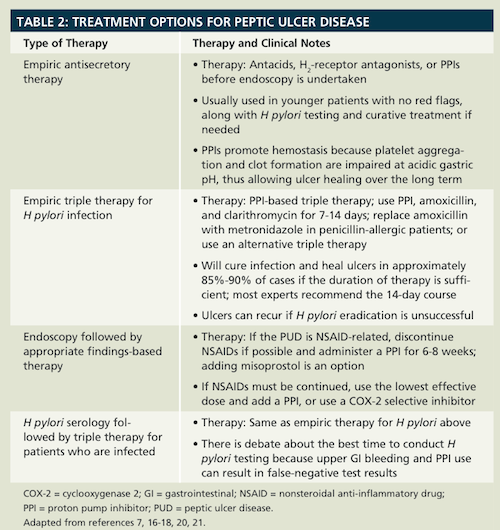Publication
Article
Pharmacy Times
Peptic Ulcer Disease
Author(s):
With 10% of Americans contracting ulcers, pharmacists should be familiar with the causes and treatments.
With 10% of Americans contracting ulcers, pharmacists should be familiar with the causes and treatments.
One in 10 Americans will develop a peptic ulcer during their lifetime.1 Until the '70s, ulcers were considered a chronic, relapsing “man’s disease,” erroneously associated with the stress of working hard to support a family and with heavy drinking. Today, however, we know more about the real causes of peptic ulcer disease (PUD) and see that men and women are affected approximately equally. Due to heightened awareness, earlier testing, and infection eradication, PUD’s prevalence, incidence, and related mortality and morbidity have declined in recent years.2,3
Painful Lesions: Description and Causes
PUD is ulceration of an acidic area of the gastrointestinal (GI) tract—either the stomach or duodenum. The esophagus is affected rarely. The combination of increased hydrochloric acid and pepsin and lower GI mucosal defenses allows painful lesions to develop. These mucosal erosions are usually 0.5 cm or larger. PUD is not gastritis or simple erosion, and although it is often confused with these states, its deeper penetration and potential for bleeding make it much more serious. The acidic environment makes ulcers extremely painful. Four times as many peptic ulcers develop in the duodenum as in the stomach, where a small number (~4%) are malignant.4-6
Patients who have chronic inflammation of the GI tract secondary to bacterial colonization with Helicobacter pylori are at elevated risk; this organism causes up to 70% of PUD. H pylori may cause hypergastremia and direct mucosal damage.1 It is also a risk factor for gastric cancer, so gastroenterologists take biopsies during endoscopy.
People who have heartburn or gastroesophageal reflux disease or are frequent users of NSAIDs alone (including low-dose aspirin) or in combination with glucocorticoids are at high risk for PUD.7,8 These drugs cause topical irritation of the gastric epithelial cells and reduce protective prostaglandin synthesis. Risk of perforation and obstruction increases with each year of NSAID use.7 Lifestyle factors (possibly heavy alcohol intake, smoking9,10), severe physiologic stress (burns, sepsis, multiorgan failure), hypersecretory states, and genetic factors have also been identified as risk factors. Increasing age is an important risk factor. Patients with multiple risk factors—especially age and NSAID use or H Pylori infection and smoking—are at a greatly increased risk.11-13
Diagnosis and Clinical Presentation

Patients with uncomplicated PUD usually report gnawing or burning sensations after meals, and sometimes bloating or fullness. Many report nocturnal pain. Symptoms vary with the ulcer’s location and the patient’s age; the very young and very old may not report pain until the ulcer has progressed significantly.11,14 Classic gastric ulcers cause pain shortly after meals, while duodenal ulcers are usually associated with pain afterward. Most patients have vague symptoms, but those who show “red flags” (Table 1) need immediate referral to a gastroenterologist. Red flag patients and patients older than 45 years should be scheduled for endoscopy quickly.15
PUD diagnosis starts with a review of the patient’s history. If the clinician suspects PUD, radiographic and endoscopic confirmation almost always follow. Upper GI endoscopy allows clinicians to visualize the ulcer, measure its size, determine the presence and degree of active bleeding, and physically intervene to stop bleeding if necessary.6
Because H pylori infection predisposes patients to PUD, and more than 70% of ulcers can be cured when the bacteria are eradicated, testing for these bacteria is critical.7 Noninvasive H pylori testing includes a urea breath test, a fecal antigen test, and antibody testing.6
PUD’s major complications include gastric or duodenal perforation, upper GI hemorrhage, stricture at the ulcer site, and rarely, gastric outlet obstruction. Bleeding is the most common and serious PUD complication, and mortality is 5% to 10%.6
Treatment
Etiology and presentation dictate treatment (Table 2); supportive care, acid reduction, and endoscopic hemostasis are the cornerstone of treatment. Most PUD patients can be treated successfully using drugs to eradicate H pylori infection7,16 and/or having them avoid NSAIDs. In addition, acid reduction— usually using PPIs—is standard of care.17,18 The optimal PPI dose and route of administration remains controversial, so clinicians use their judgment to select therapy.19 Patients who have bleeding that cannot be stopped during endoscopy or perforation need immediate surgery.6

Follow-up
Ulcer healing usually takes 6 to 8 weeks. Endoscopy is required to document healing of gastric ulcers and to rule out gastric cancer. The endoscopy is usually performed 6 to 8 weeks after the initial diagnosis of PUD. For patients with complicated H pylori—related ulcers, a noninvasive test should be conducted to verify cure.
Conclusion
With 10% of Americans contracting an ulcer in their lifetime, pharmacists should be familiar with PUD’s basic causes, red flags, and best treatments. Remember that some drugs may cause peptic ulcers: intra-arterial 5-fluorouracil, potassium chloride tablets, crack cocaine, and bisphosphonates. With appropriate treatment and good patient adherence, most ulcers will be cured.
Ms. Wick is a visiting professor at the University of Connecticut School of Pharmacy and a freelance clinical writer.
References
- Centers for Disease Control and Prevention. Helicobacter pylori and peptic ulcer disease. www.cdc.gov/ulcer/economic.htm. Accessed May 31, 2013.
- Wang AY, Peura DA. The prevalence and incidence of Helicobacter pylori—associated peptic ulcer disease and upper gastrointestinal bleeding throughout the world. Gastrointest Endosc Clin N Am. 2011;21:613-635.
- Feinstein LB, Holman RC, Yorita Christensen KL, Steiner CA, Swerdlow DL. Trends in hospitalizations for peptic ulcer disease, United States, 1998—2005. Emerg Infect Dis [serial on the Internet]. http://wwwnc.cdc.gov/eid/article/16/9/09-1126.htm. Published 2010. Accessed May 31, 2013.
- Malfertheiner P, Chan FK, McColl KE. Peptic ulcer disease. Lancet. 2009;374:1449-1461.
- Napolitano L. Refractory peptic ulcer disease. Gastroenterol Clin North Am. 2009;38:267-288.
- Cheifetz AS, Bloom S, Webster G, Moss AC, eds. Webster Oxford American Handbook of Gastroenterology and Hepatology. New York: Oxford University Press; 2011.
- Tang CL, Ye F, Liu W, Pan XL, Qian J, Zhang GX. Eradication of Helicobacter pylori infection reduces the incidence of peptic ulcer disease in patients using nonsteroidal anti-inflammatory drugs: a meta-analysis. Helicobacter. 2012;17:286-296.
- Musumba C, Jorgensen A, Sutton L, et al. The relative contribution of NSAIDs and Helicobacter pylori to the aetiology of endoscopically diagnosed peptic ulcer disease: observations from a tertiary referral hospital in the UK between 2005 and 2010. Aliment Pharmacol Ther. 2012;36:48-56.
- Aldoori WH, Giovannucci EL, Stampfer MJ, Rimm EB, Wing AL, Willett WC. A prospective study of alcohol, smoking, caffeine, and the risk of duodenal ulcer in men. Epidemiology. 1997;8:420-424.
- Sonnenberg A, Müller-Lissner SA, Vogel E, et al. Predictors of duodenal ulcer healing and relapse. Gastroenterology. 1981;81:1061-1067.
- Yachimski PS, Friedman LS. Gastrointestinal bleeding in the elderly. Nat Clin Pract Gastroenterol Hepatol. 2008;5:80-93.
- Udd M, Miettinen P, Palmu A, et al. Analysis of the risk factors and their combinations in acute gastroduodenal ulcer bleeding: a case-control study. Scand J Gastroenterol. 2007;42:1395-1403.
- Koivisto TT, Voutilainen ME, Färkkilä MA. Effect of smoking on gastric histology in Helicobacter pylori—positive gastritis. Scand J Gastroenterol. 2008;43:1177-1183.
- Zullo A, Hassan C, Campo SM, Morini S. Bleeding peptic ulcer in the elderly: risk factors and prevention strategies. Drugs Aging. 2007;24:815-828.
- Trawick EP, Yachimski PS. Management of non-variceal upper gastrointestinal tract hemorrhage: controversies and areas of uncertainty. World J Gastroenterol. 2012;18:1159-1165.
- Chey WD, Wong BC. American College of Gastroenterology guideline on the management of Helicobacter pylori infection. Am J Gastroenterol. 2007;102:1808-1825.
- Lai KC, Lam SK, Chu KM, et al. Lansoprazole for the prevention of recurrences of ulcer complications from long-term low-dose aspirin use. N Engl J Med. 2002;346:2033-2038.
- Lai KC, Lam SK, Chu KM, et al. Lansoprazole reduces ulcer relapse after eradication of Helicobacter pylori in nonsteroidal anti-inflammatory drug users: a randomized trial. Aliment Pharmacol Ther. 2003;18:829-836.
- Leontiadis GI, Howden CW, Barkun AN. High-dose versus low-dose intravenous proton pump inhibitor treatment for bleeding peptic ulcers. Expert Rev Gastroenterol Hepatol. 2012;6:675-677.
- Barkun AN, Cockeram AW, Plourde V, Fedorak RN. Review article: acid suppression in non-variceal acute upper gastrointestinal bleeding. Aliment Pharmacol Ther. 1999;13:1565-1584.
- Griñó P, Pascual S, Such J, et al. Comparison of diagnostic methods for Helicobacter pylori infection in patients with upper gastrointestinal bleeding. Scand J Gastroenterol. 2001;36:1254-1258.







